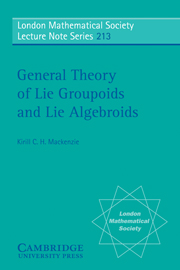Prologue
Published online by Cambridge University Press: 05 April 2013
Summary
Groupoids possess many of the features which give groups their power and importance, but apply in situations which lack the symmetry which is characteristic of group theory and its applications. Though only developed since the mid 20th century, the modern concept of Lie groupoid is as much entitled as is the familiar concept of Lie group to be regarded as the rigorous formulation of the 19th century notion which went under the then vague term ‘continuous group of local transformations’; a case could be made that the modern concept of Lie group has been a transitional stage in the evolution of the notion of Lie groupoid.
Groups arise primarily, though not exclusively, in connection with symmetry; that is, as sets of automorphisms of geometric or other mathematical structures. From this viewpoint, groupoids are the natural formulation of a symmetry system for objects which have a bundle structure. The most immediate illustration from geometry is to think of a tangent bundle: with each tangent space there is at first associated a general linear group, and the presence of a geometric structure on the manifold — such as a metric, or a complex structure — is reflected in the replacement of this group by a subgroup — such as the orthogonal or complex linear group. But a tangent space is a linear approximation to the manifold only near a single point and any geometrical study will involve moving from point to point within the manifold.
- Type
- Chapter
- Information
- General Theory of Lie Groupoids and Lie Algebroids , pp. xi - xivPublisher: Cambridge University PressPrint publication year: 2005

